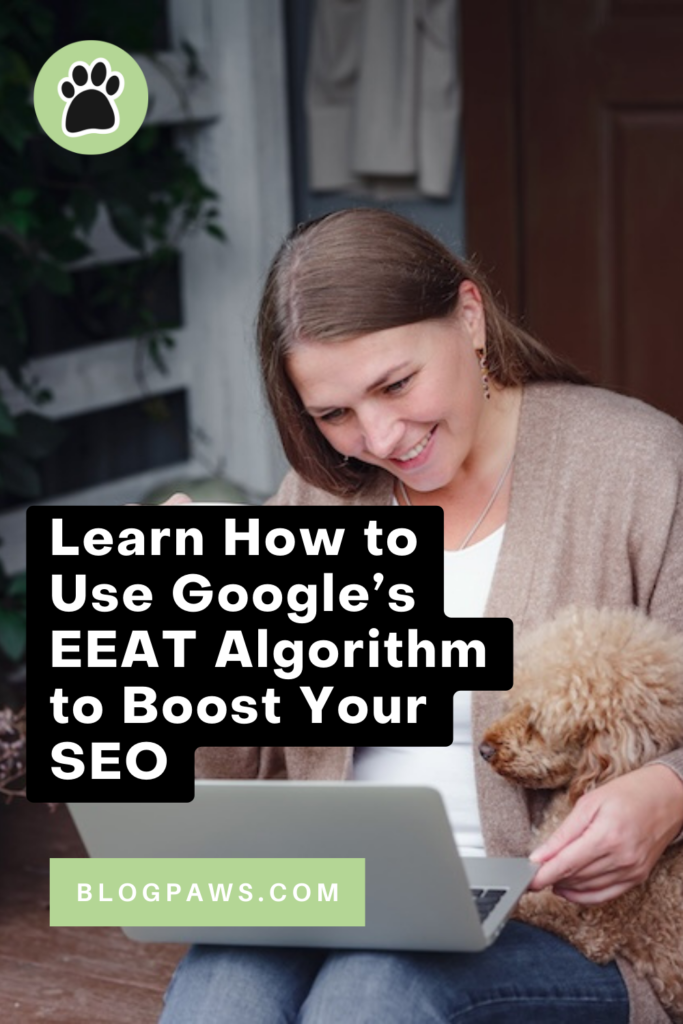Demystifying Google E-E-A-T for SEO: Your Guide to Expertise, Experience, Authoritativeness, and Trustworthiness
In the ever-evolving landscape of search engine optimization (SEO), understanding algorithms and ranking factors continues to be an important part of ensuring you are doing as much as you can for your website to be found. One of those aspects is Google E-E-A-T, which stands for Expertise, Experience, Authoritativeness, and Trustworthiness.
But what exactly is EEAT? And how does it influence your search engine ranking positions (SERPs)?
We’re going to dive deep into the world of EEAT and answer the questions we frequently hear when working with pet bloggers and small pet businesses to improve their SEO and SERPs.

What is Google EEAT?
E-E-A-T stands for Expertise, Experience, Authoritativeness, and Trustworthiness. This set of guidelines helps Google evaluate your site and its contents. It is not a direct ranking factor, but it is used to determine how relevant and helpful people find your content.
The key word there is: people.
While all four of these elements are significant in your content creation efforts, Google emphasizes the importance of trust. All content needs to build and foster trust with your readers. There may be times that you may lean into experience or expertise, depending on the topic you are addressing, but trust is always relevant.
How Does Google Actually Implement EEAT?
Google uses search quality raters from around the world to give insights on whether Google’s algorithms (and all their updates) are providing good results to those using their search engine. They analyze the quality of the results using several different factors, most notably those highlighted by EEAT.
Per Google, these are simply “people who help confirm our changes are working well.” They do not directly affect what you see on the search engine results pages (SERPs). They are more like a focus group providing feedback to ensure the algorithms work as Google intends.
Believe it or not, Google does intend that its results deliver the best content for what it believes you are searching for, or for your search intent – that’s a whole other topic.
Why is Google E-E-A-T Important for Your SEO?
The EEAT guidelines can directly impact your search performance, helping or hindering your ability to make it to the top spots in the SERPs. As a small business owner who wants your content to be seen by your ideal customers when they search for relevant terms, anything that influences your rankings is an integral part of your SEO marketing efforts.
These are just some of the benefits of focusing on incorporating EEAT when creating content:
- Increase your credibility and trust: None of us ever intends to create content that does not convey trust, but ensuring we keep it at the forefront means actively building credibility with our readers and showing our authority. Sometimes, we forget things that feel like second nature to us, but we should include them and explain even the more straightforward concepts in our content to demonstrate our knowledge and understanding of our niche. It helps both our readers and the bots know that our website and content are reliable and trustworthy sources of information. Trust encourages engagement and return readers.
- Increase your ranking potential: When you demonstrate your commitment to EEAT, your content is more likely to rank higher in SERPs, especially for content focused on “Your Money or Your Life” (YMYL) topics, like pet health or legal information.
- Creating sustainable growth: Building trust and authority takes time and dedication. But when you consistently create content with that in mind, it pays off in the long run. Focusing on EEAT helps you achieve sustainable growth through organic traffic rather than short-lived boosts from old or manipulative SEO tactics. Keyword stuffing, anyone? Nope. Not here.
Understanding the Four Pillars of EEAT
Let’s go deeper into each component of EEAT and how to strengthen them on your site:
1. Expertise
- Demonstrate your qualifications: Clearly showcase your credentials and your expertise in your content. If you are writing pet health content, share how you know what you know. If you have awards related to your niche, make sure you share them in your short bio and/or your About page.
- Leverage data and research: When it is called for in your content, quote and link to credible data, statistics, and research from trusted sources. Remember, Google crawls the links in your content to evaluate if they are helpful and offer information that supports the topic.
- Partner with experts: We love collaboration. When you bring in quotes from experts, like veterinarians, trainers, nutritionists, legal experts, or other people with your expertise, you show your commitment to providing diverse perspectives and the highest quality information. Make sure if you get quotes from people that you can showcase their credentials and expertise.
2. Experience
- Highlight IRL situations: Experience goes beyond expertise, which is not to say it’s better. They are different. You may be an expert cat agility trainer, but if you have never worked with 6 kittens training to walk a tightrope together, then you can’t share how you did it. You can share what you would try based on your expertise. Experience goes beyond tips and knowledge. Experience shows the reader what was done, and when you apply it to what happens in real life, then you also earn trust. Experience is very important for product review content. Go beyond sharing what you liked about the product. Share what it was like from the moment you opened the package so your reader can get a full understanding of what it means to purchase and use it.
- Focus on your niche: Concentrate on topics where you have demonstrable experience and expertise. You do not need expertise to share your experience with a product or in a certain situation, and you do not need to experience every situation to share your expertise about a topic. But when you can complement one with the other, that’s a big win. It means you know things, and you do things. They support each other.
- Embrace diverse perspectives: It’s important to remember to share other views on a product or topic when you are sharing your experience. It can be as simple as saying, “I think someone with a small dog would benefit more from this product than my large dog.” You can also use other people’s experiences to share different viewpoints.
3. Authoritativeness
- Share your awards and mentions: We’ve all seen the “As seen in” sections of websites. Those support the site’s authority. Where have you been seen? What awards have you won? Whenever you get public recognition, be sure you are sharing that on your site. External validation reinforces your authority and your expertise.
- Create an online presence: We often ask our PetBiz Collaborative members (our paid membership group), “What do you want to be known for?” Knowing that allows you to confidently engage in online communities, participate in relevant forums and discussions, and share valuable insights about your expertise. Engaging on Facebook, Instagram, TikTok, and Twitter can help with that, too. But notice we said, “engage.” You can’t just post and ghost. If you want to establish your thought leadership and position as an authority figure in your field, you must engage.
- Build backlinks from high-quality websites: Backlinks have a place, and we wanted to mention them. When you earn backlinks from credible sources in your niche, it helps build your authority. If you are guest blogging, have them link to your About page, not your home page. You want to link to the place that clearly shows all the components of EEAT. Don’t forget that you can link to yourself to strengthen your content, otherwise known as internal linking.
4. Trustworthiness
- Prioritize transparency and accuracy: Seems obvious, but this is one of the places that we sometimes overlook because we are so close to our own content. Not only do you need to ensure your content is factually accurate, clear on your perspective, and well-researched, but be sure you are citing your sources (which may be yourself!), disclosing potential conflicts of interest, and that you are upfront about any affiliate or sponsored relationships.
- Maintain high ethical standards: Again, this seems obvious, but we’ve probably all been taken by what appeared to be a quick hack at one point or another. Always avoid misleading information, clickbait tactics, and spammy practices. Building trust involves upholding ethical standards and providing genuine value to your audience. It’s hard for us to believe anyone in the pet industry would be spammy, but there are people. Not you, of course.
- Embrace user feedback: This goes back to the engagement part of the authority. When you respond to user comments and feedback promptly and professionally, you build trust. Address concerns, acknowledge errors, and demonstrate your commitment to continuous improvement.
Putting EEAT into Action: Practical Tips
Implementing EEAT is entirely in your control. But keep in mind that this is a long game. You won’t see the results overnight.
Here are some practical tips to get you started:
- Conduct an EEAT audit: Start with your About page. Are you including all areas of EEAT on your About page? Look on all pages on your site to evaluate your content, identifying areas where you can demonstrate stronger expertise, experience, authoritativeness, and trustworthiness. Also, check your social profiles. Are your bios aligned with content that shares your EEAT?
- Focus on quality over quantity: Prioritize creating high-quality content that offers unique value and insights. Don’t write for word count or bots. Write as if you are speaking to your readers and give them the information they need based on the topic you are writing about. Make sure to include new perspectives to make your content stand out.
- Optimize for readability and accessibility: Ensure your content is well-structured, easy to navigate, and accessible to all users. Check ADA Compliance laws for websites and follow them. Use relevant headings, clear language, and alt text for images.
- Fact-check meticulously: Double-check the accuracy of all statistics and information. Cite credible sources wherever applicable.
- Use a bio on each blog post: Even if you are the only one who writes on your site, be sure you have a short bio that speaks to your EEAT at the end of every post. Link that bio to either your About page or to LinkedIn (if that is relevant).
As you focus on creating content with Google EEAT in mind, you will want to regularly evaluate user engagement metrics like comments, shares, and time spent on page. Check your SERPs to see how they are improving and where you can continue to improve.
Don’t forget that building a strong standing with Google through the EEAT guidelines is an ongoing journey.
By consistently focusing on providing high-quality, trustworthy content and demonstrating your expertise and experience, you can establish your content as a reliable source of information in the pet industry.
In what ways do you currently leverage the EEAT guidelines in your content? In reading this, did you identify any opportunities for improvement? Share your thoughts in the comments.
About the Author: Chloe DiVita, BlogPaws CEO, has 15+ years of experience in digital marketing, the pet industry, and as a greyhound mom. She’s earned accolades like, Pet Age’s 40 Under 40 and Muse Medallions from the Cat Writers’ Association. Formerly Executive Producer for TEDxCambridge, she brings storytelling and public speaking to her work with creators, leaders, and brands. Read more…





